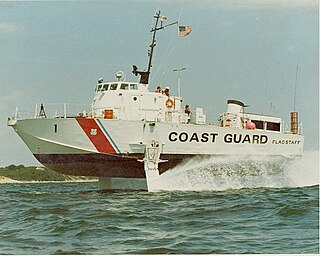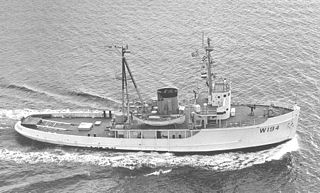The United States Navy, United States Coast Guard, and United States National Oceanic and Atmospheric Administration (NOAA) use a hull classification symbol to identify their ships by type and by individual ship within a type. The system is analogous to the pennant number system that the Royal Navy and other European and Commonwealth navies use.

The Pegasus-class hydrofoils were a series of fast attack patrol boats employed by the United States Navy. They were in service from 1977 until 1993. These hydrofoils carried the designation "PHM" for "Patrol Hydrofoil, Missile." The Pegasus-class vessels were originally intended for NATO operations in the North Sea and Baltic Sea. Subsequently, participation by other NATO navies, including Germany and Italy, ceased and the U.S. Navy proceeded to procure six PHMs, which were highly successful in conducting coastal operations, such as narcotics interdiction and coastal patrol, in the Caribbean basin.

USS Pegasus (PHM-1) was the lead ship of her class of hydrofoils operated by the United States Navy. Pegasus-class vessels were designed for high speed and mobility, and carried a powerful armament for their size.

USS Aries (PHM-5) was the fifth ship of her class of hydrofoils operated by the United States Navy. Pegasus class vessels were designed for high speed and mobility. Despite being small in size, they carried a large 76 mm gun. Aries was named for the constellation.

USS Bisbee (PF-46) was a United States Navy Tacoma-class frigate in commission from 1944 to 1945 and from 1950 to 1951. She also served in the Soviet Navy as EK-17 and in the Colombian National Armada as ARC Capitán Tono.

USS Allentown (PF-52), a United States Navy Tacoma-class frigate in commission from 1944 to 1945, has thus far been the only U.S. Navy ship to be named for Allentown, Pennsylvania. She later served in the Soviet Navy as EK-9 and in the Japan Maritime Self-Defense Force as JDS Ume (PF-9), JDS Ume (PF-289) and as YAC-14.

The USS Tucumcari (PGH-2) was a Boeing-built hydrofoil. Named after Tucumcari, New Mexico, it was the basis for the technology used in the subsequent Pegasus-class patrol boats and the Jetfoil ferries. Its unique feature was a waterjet propulsion and a computer-controlled fully submerged foil configuration of one foil at the bow and foils on the port and starboard sides. The Tucumcari was one of two prototype boats contracted by the Navy under project SCB 252 for the purpose of evaluating the latest hydrofoil technology. The second boat was the rival Grumman-built USS Flagstaff (PGH-1).

USS Tempest (PC-2) is the second of the Cyclone-class of United States Navy coastal patrol ships, named for various weather phenomena. She was transferred to the US Coast Guard as USCGC Tempest (WPC-2), on 1 October 2004, and placed in 'Commission Special' status until December 2005, when she was formally commissioned as a Coast Guard cutter. She was returned to the US Navy on 22 August 2008.

USS Flagstaff (PGH-1) was the only Flagstaff-class patrol gunboat (hydrofoil) and was acquired by the United States Navy because of her relatively low cost and very high speed. She was later loaned by the Navy to the U.S. Coast Guard, as USCGC Flagstaff (WPBH-1). The Coast Guard’s interest in the craft was the craft’s speed and its ability to interdict smugglers and other suspicious craft approaching the U.S. coast.

USS Plainview (AGEH–1) was, in its time, the world's largest hydrofoil. Named after the cities of Plainview, New York and Plainview, Texas, she was also the United States Navy's first hydrofoil research ship. Plainview was designed under project SCB 219; laid down 8 May 1964 by the Lockheed Shipbuilding and Construction Company, Seattle, Washington; launched 28 June 1965; sponsored by Mrs. John T. Hayward; and placed in service on 3 March 1969. She cost $21 million to construct.

USS Coronis (ARL-10) was one of 39 Achelous-class repair ship landing craft built for the United States Navy during World War II. Named for Coronis, she was the only US Naval vessel to bear the name.
USS Barricade (ACM-3) was a Chimo-class minelayer in the United States Navy during World War II.

USS Barbican (ACM-5) was a Chimo-class minelayer in the United States Navy. Barbican was later commissioned in U.S. Coast Guard as USCGC Ivy.

USS Kretchmer (DE-329) was an Edsall-class destroyer escort built for the U.S. Navy during World War II. She served in the Atlantic Ocean and the Pacific Ocean and provided destroyer escort protection against submarine and air attack for Navy vessels and convoys.

The third USS Casco (AVP-12) was a United States Navy Barnegat-class small seaplane tender in commission from 1941 to 1947. She saw service in World War II. After her decommissioning, the U.S. Navy loaned her to the United States Coast Guard, in which she served as the cutter USCGC Casco (WAVP-370), later WHEC-370, from 1949 to 1969.

The second USS Wampanoag (ATA-202), originally USS ATA-202, is a United States Navy auxiliary ocean-going tug in commission from 1945 to 1947.

The auxiliary ocean tug USS ATA-194 was laid down on 7 November 1944 at Orange, Texas, by the Levingston Ship Building Co.; launched 4 December 1944; and commissioned at Orange on 14 February 1945.
USCGC Tupelo WAGL/WLB-303, was a Cactus (A) Class 180-foot buoy tender vessel built by Zenith Dredge Company of Duluth, Minnesota. Her keel was laid 15 August 1942, launched 28 November 1942 and commissioned on 30 August 1943. She was built as a WAGL and redesignated a WLB in 1965.

USS Katie (SP-660) is a civilian motor vessel which was commissioned into the United States Navy as a patrol vessel from 1917 to 1918.

USS YF-339 was an American YF-257-class covered lighter built in 1944 for service in World War II. She was later acquired by the United States Coast Guard and renamed USCGC White Bush (WAGL-542).
















